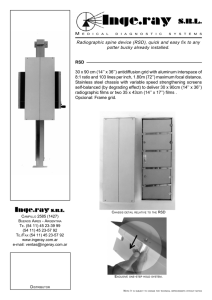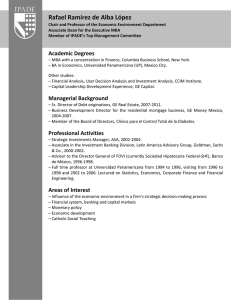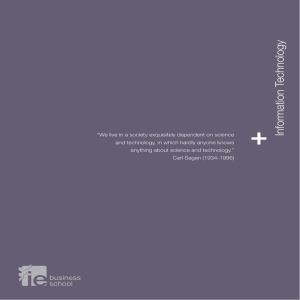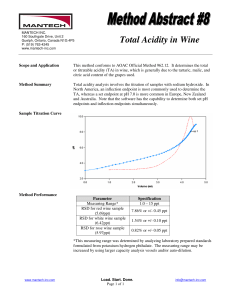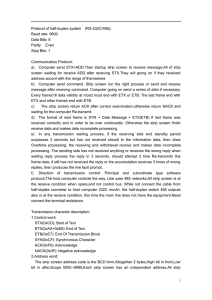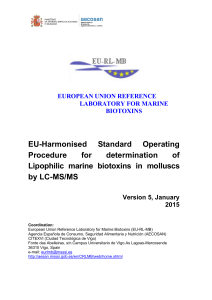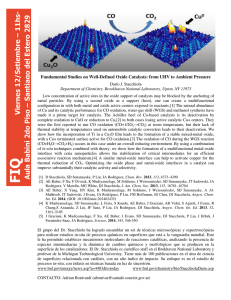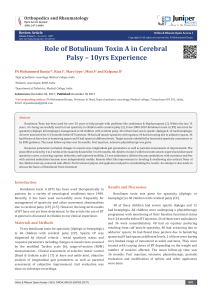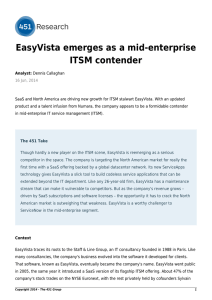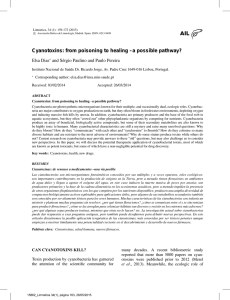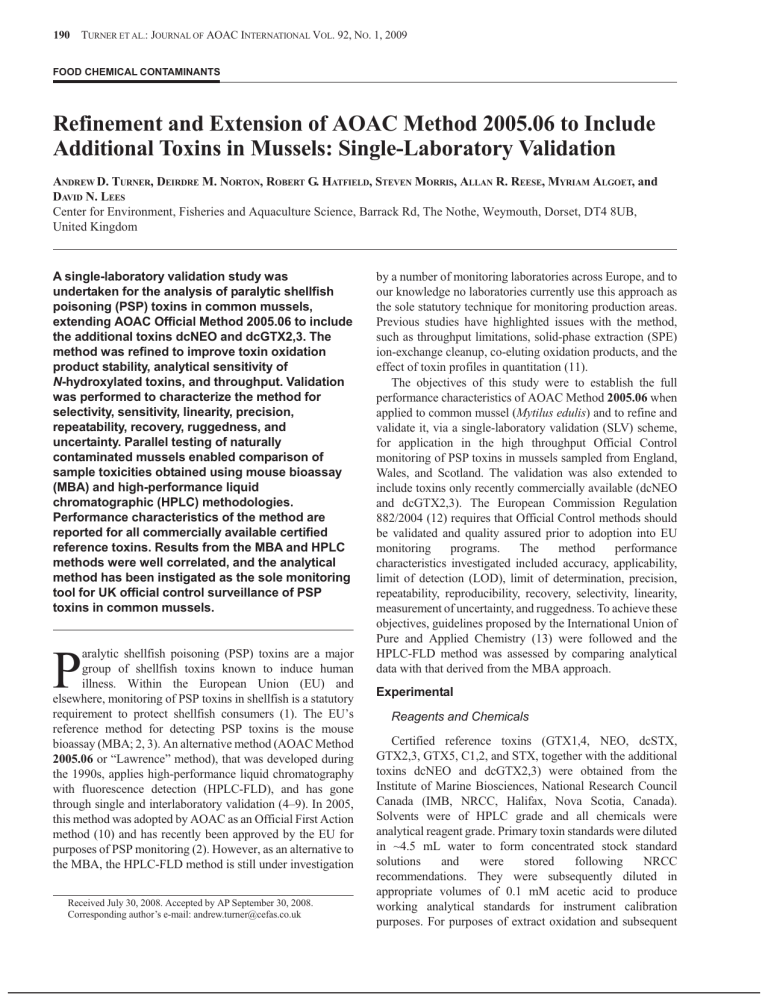
190 TURNER ET AL.: JOURNAL OF AOAC INTERNATIONAL VOL. 92, NO. 1, 2009 FOOD CHEMICAL CONTAMINANTS Refinement and Extension of AOAC Method 2005.06 to Include Additional Toxins in Mussels: Single-Laboratory Validation ANDREW D. TURNER, DEIRDRE M. NORTON, ROBERT G. HATFIELD, STEVEN MORRIS, ALLAN R. REESE, MYRIAM ALGOET, and DAVID N. LEES Center for Environment, Fisheries and Aquaculture Science, Barrack Rd, The Nothe, Weymouth, Dorset, DT4 8UB, United Kingdom A single-laboratory validation study was undertaken for the analysis of paralytic shellfish poisoning (PSP) toxins in common mussels, extending AOAC Official Method 2005.06 to include the additional toxins dcNEO and dcGTX2,3. The method was refined to improve toxin oxidation product stability, analytical sensitivity of N-hydroxylated toxins, and throughput. Validation was performed to characterize the method for selectivity, sensitivity, linearity, precision, repeatability, recovery, ruggedness, and uncertainty. Parallel testing of naturally contaminated mussels enabled comparison of sample toxicities obtained using mouse bioassay (MBA) and high-performance liquid chromatographic (HPLC) methodologies. Performance characteristics of the method are reported for all commercially available certified reference toxins. Results from the MBA and HPLC methods were well correlated, and the analytical method has been instigated as the sole monitoring tool for UK official control surveillance of PSP toxins in common mussels. P aralytic shellfish poisoning (PSP) toxins are a major group of shellfish toxins known to induce human illness. Within the European Union (EU) and elsewhere, monitoring of PSP toxins in shellfish is a statutory requirement to protect shellfish consumers (1). The EU’s reference method for detecting PSP toxins is the mouse bioassay (MBA; 2, 3). An alternative method (AOAC Method 2005.06 or “Lawrence” method), that was developed during the 1990s, applies high-performance liquid chromatography with fluorescence detection (HPLC-FLD), and has gone through single and interlaboratory validation (4–9). In 2005, this method was adopted by AOAC as an Official First Action method (10) and has recently been approved by the EU for purposes of PSP monitoring (2). However, as an alternative to the MBA, the HPLC-FLD method is still under investigation Received July 30, 2008. Accepted by AP September 30, 2008. Corresponding author’s e-mail: [email protected] by a number of monitoring laboratories across Europe, and to our knowledge no laboratories currently use this approach as the sole statutory technique for monitoring production areas. Previous studies have highlighted issues with the method, such as throughput limitations, solid-phase extraction (SPE) ion-exchange cleanup, co-eluting oxidation products, and the effect of toxin profiles in quantitation (11). The objectives of this study were to establish the full performance characteristics of AOAC Method 2005.06 when applied to common mussel (Mytilus edulis) and to refine and validate it, via a single-laboratory validation (SLV) scheme, for application in the high throughput Official Control monitoring of PSP toxins in mussels sampled from England, Wales, and Scotland. The validation was also extended to include toxins only recently commercially available (dcNEO and dcGTX2,3). The European Commission Regulation 882/2004 (12) requires that Official Control methods should be validated and quality assured prior to adoption into EU monitoring programs. The method performance characteristics investigated included accuracy, applicability, limit of detection (LOD), limit of determination, precision, repeatability, reproducibility, recovery, selectivity, linearity, measurement of uncertainty, and ruggedness. To achieve these objectives, guidelines proposed by the International Union of Pure and Applied Chemistry (13) were followed and the HPLC-FLD method was assessed by comparing analytical data with that derived from the MBA approach. Experimental Reagents and Chemicals Certified reference toxins (GTX1,4, NEO, dcSTX, GTX2,3, GTX5, C1,2, and STX, together with the additional toxins dcNEO and dcGTX2,3) were obtained from the Institute of Marine Biosciences, National Research Council Canada (IMB, NRCC, Halifax, Nova Scotia, Canada). Solvents were of HPLC grade and all chemicals were analytical reagent grade. Primary toxin standards were diluted in ~4.5 mL water to form concentrated stock standard solutions and were stored following NRCC recommendations. They were subsequently diluted in appropriate volumes of 0.1 mM acetic acid to produce working analytical standards for instrument calibration purposes. For purposes of extract oxidation and subsequent TURNER ET AL.: JOURNAL OF AOAC INTERNATIONAL VOL. 92, NO. 1, 2009 191 Table 1. Toxin mixtures used in this study Toxin mixture Toxins I GTX1,4, NEO, dcNEO II STX, dcSTX, GTX2,3, GTX5 III C1,2, dcGTX2,3 IV dcGTX2,3 and dcSTX V All toxins quantitation, toxin standard mixes (I–V) were prepared as recommended (10) and are illustrated in Table 1. Periodate oxidation of Mix IV was applied when naturally contaminated samples were quantified to enable estimation of both the dcSTX contribution to NEO/dcNEO and the dcGTX2,3 contribution to GTX1,4 as described previously (10). Preparation and Extraction of Shellfish Samples Approximately 0.5 kg of both common mussels (M. edulis) and Pacific oysters (Crassostrea gigas, for matrix modifier) were homogenized and stored at –20°C until required. To ensure that these materials were free of PSP toxins prior to their use in the validation schemes, 5.0 g (±0.1 g) samples were transferred to 50 mL polypropylene centrifuge tubes, extracted, and analyzed according to AOAC Method 2005.06 and chromatograms were compared against those derived from the analysis of oxidized PSP standard solutions. Archived mussel samples were acquired from shellfish production areas sampled under the English, Welsh, and Scottish Official Control monitoring programs and had been stored at –20°C since arrival and homogenization. Matrix modifier was prepared following a protocol modified from the AOAC method. Liquid Chromatography and PSP Toxin Quantitation LC separation was performed using a Gemini C18 reversed-phase column (150 ´ 4.6 mm, 5 mm; Phenomenex, Manchester, UK) with a Gemini C18 guard column (set at 35°C). An Agilent (Stockport, UK) fluorescence detector (1200 model FLD) was used to detect the oxidation products of all PSP toxins. Fluorescence excitation was set to 340 nm and emission to 395 nm. Mobile phase (A): 0.1 M ammonium formate, adjusted to pH 6 ± 0.1 with 0.1 M acetic acid; (B): 0.1 M ammonium formate with 5% acetonitrile, also adjusted to pH 6 ± 0.1 with 0.1 M acetic acid. The mobile phase was delivered by an Agilent 1200 series LC at a flow rate of 2 mL/min. The LC gradient was as follows: 0–5% mobile phase B in the first 5 min, 5–70% B for the next 4 min, hold at 70% B for 1 min, and back to 100% A over the next 2 min. The 100% A was held for an additional 2 min to allow for column equilibration before subsequent sample injections. Individual toxins and multiple toxin mixes were oxidized using both periodate and peroxide oxidation (4–10) and 30–50 mL volumes were injected. Chromatographic data were reviewed to ascertain retention times and relative peak area responses of the toxins oxidized under both oxidation conditions. The toxicity equivalence factors (TEFs) described by Oshima (14) were used. These factors were incorporated into the calculations for preparation of calibration solutions for each toxin mix, so that the calibration range for each toxin equated to 0–0.96 mg STX eq/g. The exception was GTX5, where calibration solutions were prepared at 10% of the concentration of other toxins (0–0.096 mg STX eq/g). In the case of isomeric pairs (GTX1,4, GTX2,3, C1,2, and dcGTX2,3), the highest TEF was used for each pair. Individual toxin concentrations were reported as mg STX dihydrochloride eq/g, and the total PSP toxicity was calculated by summing the individual concentration contributions from all quantified toxins and is quoted in terms of mg STX di-HCl eq/100 g. Extraction, Cleanup, and Oxidation of Samples The extraction and extract oxidation procedures of Lawrence (9) and AOAC Method 2005.06 (10) were followed as closely as possible. Matrix modifier was prepared from Pacific oyster homogenate shown not to contain PSP toxins, using the same extraction method, without the 2–3-day precipitation step. SPE ion-exchange cleanup was used for all samples potentially containing any of the N-hydroxylated PSP toxins GTX1,4, NEO, and dcNEO. Fraction F1 contains the N-sulfocarbamoyl C-toxins (C1,2), F2 contains the gonyautoxins (GTX) group of toxins (GTX1-5, and dcGTX2,3) and the carbamates (STX, dcSTX, and NEO) elute in F3. The AOAC Method 2005.06 can be divided into 2 parts. Initially, an HPLC-FLD qualitative screen, involving the periodate oxidation of the pH-adjusted, cleaned-up extracts, determines both the presence of PSP toxins in the samples and the potential presence of N-hydroxylated toxins. A sample was positive by the screening method when a peak with a signal-to-noise (S/N) ratio of ³3 was present at the same retention time (±2.5%) as in the analytical toxin standard. For toxins with more than one oxidation product (GTX1,4, GTX2,3, dcSTX, dcGTX2,3, and NEO), a positive sample also required the presence of at least the most significant secondary peak. For all screen-positive samples, full quantitation was subsequently performed, with all non-N-hydroxylated toxins quantified following peroxide oxidation of the C18 cleaned-up extracts. GTX1,4 was quantified following periodate oxidation of F2, and both NEO and dcNEO were quantified following periodate oxidation of F3. Optimization of SPE Ion-Exchange Fractionation AOAC Method 2005.06 describes the use of silica-bound, ion-exchange SPE cartridges for the fractionation of sample extracts. Because of concerns with method sensitivity due to the extra dilution associated with this step, and the noted impracticality of using additional evaporation steps suggested in the AOAC method in a high-throughput monitoring program, ion-exchange options were investigated to determine whether other cartridge sorbents would enable the 192 TURNER ET AL.: JOURNAL OF AOAC INTERNATIONAL VOL. 92, NO. 1, 2009 Table 2. Experimental parameters chosen for 2 ruggedness experiments Test 1 (GTX2,3 and STX) Test 2 (GTX1,4 and NEO) Extraction temperature (A = 100°C, a = 95°C) C18 extract pH (A = pH 6, a = pH 7) Vortex time for extraction (B = 30 s, b = 90 s) Fractionation flow rate (B = 2 mL/min, b = 3 mL/min) C18 cleanup flow rate (C = 2 mL/min, c = 3 mL/min) pH of cleaned-up extract (D = pH 6, d = pH 7) Ambient temperature during oxidation (E = 22°C, e = 25°C) Oxidation time (F = 1 min 55 s, f = 2 min 5 s) Chromatographic flow rate (G = 1.9 mL/min, g = 2.1 mL/min) use of lower volumes of fraction elution solvents. A suitable candidate was identified, and the elution conditions used for fractionation were optimized. Stability of Toxin Oxidation Products AOAC Method 2005.06 describes issues with toxin oxidation product stability, resulting in significant limitations for the application of the method to a high-throughput routine monitoring environment, where products must remian stable over a suitable period of time without the need for additional calibrants within the sequence. As such, the use of a cooled autosampler was investigated and the subsequent stability of toxin oxidation products was determined over a 24 h period. Single-Laboratory Method Validation Scheme C18 cleaned-up, extracted mussel tissue homogenate was oxidized by both periodate and peroxide and analyzed by HPLC-FLD. Periodate oxidation was performed in the presence of matrix modifier (10). The selectivity of the method involved analyzing oxidized sample aliquots alongside unoxidized extracts and PSP calibration standards in order to determine, qualitatively, whether mussel extracts contained any naturally fluorescing compounds that had the potential to interfere with the presence of PSP toxins. Linear range was determined by spiking PSP toxins into mussel extracts, fractions, and 0.1 mM acetic acid to produce concentrations over a range of 0–2.0 mg STX eq/g; GTX5 = 0–0.2 mg STX eq/g. Periodate and peroxide oxidations were performed in triplicate before HPLC-FLD analysis and linear regression equations were generated. The linearity of the analytical method was evaluated graphically, and comparisons were made between calibrations from acetic acid and mussel-extract-based standard solutions. Regression coefficients and statistical F-test, goodness-of-fit were examined for each calibration. Method LODs were established from a PSP toxin S/N ratio of 3:1 and were determined experimentally for both the periodate screening step and the full quantitation method using triplicate homogenate spikes at predicted LOD concentrations. Triplicate oxidations were used to assess variability of the amount. Limits of quantitation (LOQ) were experimentally determined using an S/N ratio of 10:1. Periodate oxidant pH (C = pH 8.15, c = pH 8.25) Vortex mixing time (D = 3 s, d = 6 s) Ambient temperature during oxidation (E = 22°C, e = 25°C) Oxidation time (F = 55 s, f = 65 s) Matrix modifier (G = Modifier 1, g = Modifier 2) Without the availability of a mussel certified reference material (CRM), method accuracies were investigated using 2 candidate and noncertified mussel homogenates (supplied by IMB, NRCC). Assessment of the recovery of PSP toxins from mussel tissue involved the triplicate spiking of homogenates of each toxin to provide expected concentrations relating to 0.16 mg STX eq/g and 0.40 mg STX eq/g for each toxin (GTX5 at 0.016 and 0.04 mg STX eq/g). Toxins were divided into groups of spiking mixtures (Table 1). One mixture (V) contained all of the toxins for a limited number of tests, including recovery assessment for dcNEO. Instrumental peak area precision was assessed with the repeat analysis of matrix-matched toxin standards in one analytical batch. Repeatability of chromatographic retention time was assessed with the repeat analysis of toxin standards over a 2-month period. Short-term method repeatability involved the analysis of triplicate homogenates spiked at both 0.16 and 0.40 mg STX eq/g concentration per toxin, analyzed in one analytical batch. Medium-term repeatability involved analysis of 2 batches of triplicate homogenates spiked at 0.16 and 0.40 mg STX eq/g, analyzed in 2 batches by more than one analyst more than 2 weeks apart. Long-term repeatability was assessed using the repeated extraction, cleanup, and analysis of a naturally contaminated laboratory reference material (LRM) over more than 2 months. Method precision was also assessed with 10 replicate analyses of 6 naturally contaminated mussel extracts. Intrabatch repeatability was assessed with the analysis of each extract in one analytical batch. Interbatch repeatability was investigated by analyzing each of the extracts in different analytical batches. Ruggedness was investigated by using the repeat analysis of spiked mussel homogenates and followed a Plackett-Burman experimental design (15) using key method parameters (Table 2). Ruggedness tests were conducted for model toxins (0.40 mg STX eq/g) of the non-N-hydroxylated (STX and GTX2,3) and N-hydroxylated (GTX1,4 and NEO) groups. Main effects were calculated as the difference of means for each paired set of parameter levels (parameter differences) and were tabulated in order of magnitude. The parameter difference was also calculated as a percentage of the spiked concentration (0.4 mg STX eq/g). TURNER ET AL.: JOURNAL OF AOAC INTERNATIONAL VOL. 92, NO. 1, 2009 193 Figure 1. Typical chromatographic patterns obtained with 3 mixtures of analytical standards of PSP toxins, including dcNEO and dcGTX2,3. 194 TURNER ET AL.: JOURNAL OF AOAC INTERNATIONAL VOL. 92, NO. 1, 2009 Results were used from the validation studies to calculate an overall value of method uncertainty for the measurement of PSP toxins in mussel tissue. Expanded uncertainties were also calculated (16, 17). The contribution and effects of matrix modifier and sampling uncertainty were not investigated in this study. Parallel Mussel Sample Analysis Following SLV, the HPLC-FLD method was applied in parallel with the MBA as used in the national Official Control monitoring programs for PSP toxins in shellfish. All samples were screened by HPLC-FLD and fully quantified using AOAC Method 2005.06. PSP toxin concentration data derived from HPLC-FLD analysis were compared with MBA results, and the correlation between the 2 data sets was determined statistically. Results and Discussion Method Modifications Figure 2. Trellis plot for stability of oxidation products of PSP toxins as shown by peak area responses minus mean responses of diagnostic peaks measured over 24 h. (a) HPLC-FLD profiles of PSP toxin standards.—Chromatographic elutions of each toxin were similar to those described in the AOAC study (10). dcGTX2,3 and dcNEO were not included in previous AOAC validation (10), although their chromatographic behavior has been previously described (6, 18). Oxidations of dcGTX2,3 by periodate and peroxide each revealed 2 fluorescing products, with retention times at 2.4 and 2.8 min. The 2.4 min peak did not co-elute with fluorescing products of other toxins (e.g., GTX1,4) and was thus selected for purposes of quantitation. As an N-hydroxylated toxin, dcNEO was expected to exhibit fluorescent products after periodate oxidation, and a prominent peak was observed at ~4.5 min. This peak co-eluted with the smaller of the 2 major dcSTX peaks after periodate oxidation, and an additional, minor peak was seen at ~5.2 min due to the dcSTX impurity (NRCC data sheet). Because of the relative size of the dcSTX impurity to the dcNEO, it is assumed that the effect of this impurity on dcNEO quantitation was negligible. Chromatograms of the 3 mixes of toxins used as analytical standards are shown in Figure 1. (b) Toxin oxidation product stability.—AOAC Method 2005.06 highlights issues with the stability of toxin oxidation products, advising that the stability should not be assumed beyond 8 h (10). This limitation would result in either a restricted sequence length, or the use of additional standards throughout the sequence. However, our analysis of standard stability using a temperature-controlled HPLC autosampler (set at 4°C) showed that the oxidation products of all toxins were stable for up to 24 h and potentially longer (Figure 2). (c) Refinement to ion-exchange fractionation and automated SPE.—Silica-bound ion-exchange SPE cartridges were initially tested to assess the fractionation of the toxin suite with the addition of both dcNEO and dcGTX2,3. The new toxins eluted in the expected fractions, with dcGTX2,3 eluting in fraction F2 and dcNEO eluting in fraction F3 (Table 3). Several cartridges were subsequently considered TURNER ET AL.: JOURNAL OF AOAC INTERNATIONAL VOL. 92, NO. 1, 2009 195 Table 3. Ion-exchange fractionation optimization Method AOAC 2005.06 Optimized Fraction Toxin Elution solvent Fraction volume, mL Elution solvent Fraction volume, mL F1 C1,2 Water 6.0 Water 5.0 F2 GTX1,4, GTX2,3, dcGTX2,3, GTX5 0.05 M NaCl 4.0 0.3 M NaCl 3.0 F3 STX, NEO, dcNEO, dcSTX 0.3 M NaCl 5.0 2.0 M NaCl 3.0 Figure 3. Chromatograms showing fractions (F1, F2, and F3) collected after ion-exchange SPE using Strata-X-CW of a solution containing all commercially available certified PSP reference standards. 196 TURNER ET AL.: JOURNAL OF AOAC INTERNATIONAL VOL. 92, NO. 1, 2009 Table 4. Linear regression parameters plus RSDsa of response factors and F-test of residual variance (F-critical = 1.98)b Toxin GTX1,4 dcNEO NEO dcSTX GTX2,3 Matrix Calibration gradient Intercept r2 RSD% of response factors F-test Solvent 3.06 0.13 0.968 13 0.27 Fraction F2 2.03 0.21 0.970 14 0.22 Solvent 12.61 0.40 0.995 6 0.22 Fraction F3 7.93 –0.15 0.989 8 0.52 Solvent 9.41 –0.09 0.996 8 0.13 Fraction F3 11.83 –0.50 0.963 17 0.42 Extract 68.6 0.92 0.994 5 0.44 Solvent 76.6 0.60 0.996 4 0.36 0.15 0.983 8 0.36 Extract Solvent GTX5 STX C1,2 dcGTX2,3 a b 6.87 0.01 0.968 13 0.33 Extract 108 6.64 –0.37 0.993 6 0.002 Solvent 119 –0.12 0.927 17 0.004 Extract 18.48 0.26 0.993 5 0.41 Solvent 15.91 0.25 0.956 13 0.45 Extract 21.06 1.87 0.970 13 0.17 Solvent 25.21 –0.14 0.986 7 0.53 Extract 6.82 0.72 0.986 16 0.04 Solvent 9.69 –0.80 0.902 20 0.60 RSD = Relative standard deviation. Values calculated for each PSP toxin in mussel extract, solvent, and fractions (when applicable) over working calibration range (0–0.96 mg STX eq/g; GTX5 0–0.01 mg STX eq/g). with a view to increase method sensitivity and improve the practicality of the method. The Strata-X-CW (Phenomenex) SPE cartridge contains a polymer sorbent backbone, rather than the silica stipulated by Lawrence, and an additional reverse-phase element, resulting in a modified sorbent selectivity and the need to optimize the concentrations of salt solutions used for fraction elution. Optimization results shown in Table 3 indicated that while different concentrations of sodium chloride solution were used to elute F2 and F3, the toxin compositions observed in each fraction were the same as described previously (10) and observed in this study. Furthermore, low levels of PSP toxin fraction carryover (6, 11) were not observed when this cartridge was used. Chromatograms of the 3 fractions collected following ion-exchange SPE of a solution containing all toxin standards are shown in Figure 3. Although silica ion-exchange cartridges may still be used for the method, including analyte extensions, this approach represented an overall improvement to the fractionation described in the AOAC method, both in terms of fractionation selectivity and subsequent analytical sensitivity and toxin recovery. A third advantage was the lack of cartridge de-conditioning following the introduction of air into the cartridge. Polymer SPE cartridges are ideally suited to automated SPE systems, where instrument optimization will not require checking that columns do not become dry each time they are used. The Strata-X-CW is therefore the preferred and recommended approach, although both silica-bound and polymer-bound cartridges are usable. The SPE (C18 cleanup and ion-exchange fractionation) processes are time-consuming and labor-intensive to perform manually; therefore, these processes were automated. Gilson Aspec (Anachem, Luton, UK) liquid handlers were programmed to perform both C18 cleanup and fractionation procedures, with parameters defined to produce fast, reliable, and repeatable cleanups. Volumes and flow rates were programmed according to the parameters shown in Table 3. Critical steps included proper positional adjustment of needles, racks, and sample trays, the instigation of a full and thorough system flush after each batch of cleanup, use of regular system purges before use to ensure removal of all air bubbles from the solvent flow system, and regular monitoring of sample eluant collection volumes for quality control purposes. This instrumentation was utilized throughout the subsequent validation program, enabling up to 32 C18 cleanups and 16 fractionations to be carried out within 1 h. This represented a significant reduction in manual labor and an essential requirement for application of this method to high-throughput routine monitoring in a regulatory TURNER ET AL.: JOURNAL OF AOAC INTERNATIONAL VOL. 92, NO. 1, 2009 197 Figure 4. Calibration plots of (a) dcSTX and (b) dcNEO concentration against detector response for standard prepared in cleaned-up tissue extract or fraction and solvent over the working calibration range of 0–1.2 mg STX eq/g. environment. The instrumentation was robust over a significant period of time (>2 years), and additional quality control checks were instigated to highlight any potential instrument failures. Method Validation (a) Selectivity.—The HPLC-FLD method was selective for the analysis of the majority of PSP-contaminated mussel extracts prepared in acetic acid. Chromatographic profiles of naturally fluorescing matrix co-extractives were similar to those highlighted in previous studies (6). Peaks were seen at the same retention times as the early-eluting toxins (dcGTX2,3 and GTX1,4) relating to co-extractives. Naturally contaminated mussels contain variable amounts of these interfering compounds, implying a need, as proposed in AOAC Method 2005.06, to run unoxidized samples alongside oxidized extracts. The nontoxin contributions are then subtracted from overall toxicity. Despite a degree of uncertainty, such calculations were shown to reduce the likelihood of false positives. (b) Linearity.—In all cases, results showed a linear fit to be the preferred model, with separate slopes for each matrix (solvent and extract/fraction). The results are summarized in Table 4. Statistical analysis of calibration plots using both correlation coefficients and F-test goodness-of-fit of the residuals, indicated no significant, systematic deviations from linearity within mussel extracts and fractions examined over the concentration range of 0–0.96 mg STX eq/g (0 to 0.096 for GTX5) for any of the PSP toxins studied. Differences in slope of the calibrations between solvent and mussel extracts were 198 TURNER ET AL.: JOURNAL OF AOAC INTERNATIONAL VOL. 92, NO. 1, 2009 Table 5. Comparison of calibration slope gradients, intercepts, and correlation coefficients for C1,2 in C18-cleaned mussel extract and solvent (0 to 1.0 mg STX eq/g) Toxin C1,2 Matrix Gradient (0 to 2.0 mg STX eq/g) r2 Intercept Gradient Intercept r2 Extract 21.06 1.87 0.970 12.62 6.02 0.796 Solvent 25.21 –0.14 0.986 25.01 –0.16 0.991 noticeable for the N-hydroxylated toxins GTX1,4, NEO, and dcNEO (Figure 4), whereas most non-N-hydroxylated toxins did not exhibit any such differences (e.g., dcSTX). Deviations for linearity above 0.8 mg STX eq/g were found only with C1,2 in C18 cleaned mussel extract (Table 5). (c) Limits of detection and quantitation.—LOD values were calculated for the periodate oxidation of all toxins in a cleaned-up mussel extract in order to describe the LODs for the screening element of the method (Table 6). For toxins with more than one oxidation product, the LOD values quoted represent a cautious assessment of detection limits for the primary toxin peaks, as they include confirmation of the presence of secondary peaks in all cases. LOD values ranged from ~0.03 to 0.14 mg STX eq/g with NEO and dcSTX exhibiting the lowest LODs and C1,2 showing the highest LOD at 0.14 mg STX eq/g. Table 7 presents method LODs for the quantitation of PSP toxins in mussels. The method was less sensitive for GTX1,4 (0.16 mg STX eq/g), whereas sensitivities for other toxins (0.003–0.087 mg STX eq/g) were significantly better. Due to toxin availability, the LOD value for dcNEO (0.16 mg STX eq/g) was quoted conservatively as the concentration spiked during recovery testing, where results indicated an S/N ratio >3.0. The LODs were also compared (Table 7) against the values quoted in AOAC Method 2005.06, and similar results were seen, with the exception of GTX1,4. The LOD obtained for dcGTX2,3 indicated a good level of sensitivity for this toxin in comparison with the others. LOQ values are also summarized in Table 7, ranging from 0.006 to 0.16 mg STX eq/g for the non-N-hydroxylated toxins. Results obtained for the N-hydroxylated toxins show acceptable LOQs for NEO and dcNEO (£0.16 mg STX eq/g), whereas LOQs recorded for GTX1,4 were in the region of 0.38 mg STX eq/g. The degree of confidence in the method at 0.16 mg STX eq/g may therefore be questionable for GTX1,4. However, results from the medium-term precision analysis of GTX1,4 at 0.16 mg STX eq/g show a 16% relative standard deviation (RSD) and a HorRat of 0.76; the long-term precision GTX1,4 data taken from the analysis of the LRM also showed an acceptable RSD and HorRat. These results show that the level of precision is acceptable at 0.16 mg STX eq/g and that of GTX1,4 can therefore be quantified with an acceptable degree of precision below the validated level of quantitation. (d) Accuracy.—Table 8 shows the PSP toxicities obtained by our laboratory (precolumn oxidation) and the preliminary, noncertified values for a candidate mussel reference material (CRM-PSP-Mus), as obtained by the NRCC (postcolumn oxidation). Total toxicity values as determined by MBA for the same pre-reference material [Canadian Food Inspection Agency (CFIA)] are also quoted. On a qualitative basis, all toxins identified using the AOAC method were present using the postcolumn oxidation approach, with the exception of the low-level dcNEO, which was not reported by NRCC. Relative proportions of toxins showed near-identical profiles with those calculated from the preliminary CRM. Concentrations of NEO, dcSTX, and dcGTX2,3 detected using the AOAC method were supported by the NRCC results. Concentrations of these toxins fell between 0.01 and 0.04 mg STX eq/g, at which concentrations a lower level of accuracy was expected, although there was higher accuracy obtained for the very low levels of dcGTX2,3. Table 6. LOD (mg STX eq/g ± 1 SDa) of the HPLC-FLD screening method for PSP toxins following periodate oxidation of C18-cleaned mussel extracts Peak assignment Rt, minb LOD, mg STX eq/g GTX1,4 Primary 2.8 0.08 ± 0.014 GTX1,4 Secondary 7.0 Detected dcNeo Primary 4.6 0.05 ± 0.006 NEO Primary 5.3 0.03 ± 0.002 NEO Toxin Secondary 9.6 Detected dcSTX Primary 4.5 0.03 ± 0.008 dcSTX Secondary 5.3 Detected GTX2,3 Unique 6.8 0.04 ± 0.009 GTX5 Unique 8.8 0.06 ± 0.005 STX Unique 9.5 0.07 ± 0.020 dcGTX2,3 Secondary 2.4 Detected dcGTX2,3 Primary 2.8 0.04 ± 0.010 C1,2 Unique 4.2 0.14 ± 0.025 a b SD = Standard deviation. Rt = Response time. TURNER ET AL.: JOURNAL OF AOAC INTERNATIONAL VOL. 92, NO. 1, 2009 199 Table 7. LOD and LOQ of the HPLC-FLD quantitation method for PSP toxins following periodate oxidation of fractions and peroxide oxidation of C18-cleaned mussel extracts Toxin GTX1,4 dcNEO LOD (mg STX eq/g) ± 1 SDa AOAC 2005.06 LOD (mg STX eq/g) LOQ (mg STX eq/g) ± 1 SD 0.16 ± 0.04 0.05 0.38 ± 0.09 b <0.16 NR 0.16 ± 0.04 NEO 0.068 ± 0.01 0.04 0.14 ± 0.04 dcSTX 0.007 ± 0.003 0.004 0.01 ± 0.002 GTX2,3 0.087 ± 0.03 0.08 0.17 ± 0.03 GTX5 0.003 ± 0.001 0.002 0.006 ± 0.001 STX 0.018 ± 0.007 0.022 0.04 ± 0.01 dcGTX2,3 0.053 ± 0.01 NR 0.11 ± 0.01 C1,2 0.018 ± 0.006 0.01 0.04 ± 0.01 a b SD = Standard deviation. NR = No result available. The overestimation of dcSTX using the AOAC method also resulted in the significant underestimation of NEO due to the subtraction of the dcSTX contribution. Without the subtraction of the dcSTX contribution to the NEO peak, the NEO value quantified was 0.06 mg STX eq/g, similar to the value quoted by the NRCC. This may further highlight potential issues with quantifying N-hydroxylated toxins in the presence of dcSTX and dcGTX2,3, but more likely represents the higher level of method uncertainty associated with low concentrations using both methods. Values obtained for GTX2,3 and STX using the AOAC method were both higher than those quoted by the NRCC. However, without certification of the NRCC values, it is impossible to determine whether the inferred inaccuracy is due to either or both of the 2 techniques. The MBA result was 2.60 mg STX eq/g, which compares well with the total toxicity calculated using the AOAC method. Table 9 shows the comparability between the 2 methods for a second candidate CRM (PSP-Mus-Pilot); all toxins identified qualitatively by the AOAC method were also detected by the postcolumn oxidation method. Proportions of toxins quantified by the AOAC method were similar to those reported by the NRCC values. Values for dcGTX2,3 derived from the 2 methods were close; GTX2,3 and STX values determined after precolumn oxidation were 10–30% higher than those determined by the NRCC. Values for N-hydroxylated toxins were less in agreement, but with the uncertainties associated with each method and the complexities associated with quantifying N-hydroxylated toxins, the level of comparability was encouraging. (e) Recovery from spiked mussel homogenate.—Table 10 presents the mean recovery percentages of PSP toxins from mussel tissue homogenates spiked in triplicate at 0.40 mg STX eq/g and 0.16 mg STX eq/g, respectively. Recoveries of non-N-hydroxylated toxins (STX, GTX2,3, GTX5, dcSTX, C1,2, and dcGTX2,3) spiked at 0.40 mg STX eq/g following peroxide oxidation of C18-cleaned mussel extracts range from 63 to 76%. Recoveries were not thought to be matrix-influenced as no signal suppression was identified. Similarly, the N-hydroxylated toxins (GTX1,4 and NEO) did not show any reduced recoveries at the 0.40 mg STX eq/g concentration level, with recoveries of 81 and 107%, respectively, although Table 8. Concentrations and relative proportions of PSP toxins in NRCC mussel reference material (mg STX eq/g; ± 1 SD) using Cefas AOAC method, postcolumn oxidation HPLC-FLD method (NRCC; preliminary noncertified results)a Toxin AOAC (Cefas) Postcolumn (NRCC) Accuracy using postcolumn FLD as reference, % Relative toxin proportions, % (AOAC) Relative toxin proportions, % (NRCC) GTX1,4 NDb ND — ND ND dcNEO 0.03 ± 0.012 NAc — 1 NA NEO 0.01 ± 0.004 0.06 ± 0.006 19 1 3 dcGTX2,3 0.04 ± 0.005 0.03 ± 0.003 139 2 2 C1,2 ND ND — ND ND dcSTX 0.03 ± 0.001 0.01 ± 0.001 284 1 1 GTX2,3 0.30 ± 0.02 0.18 ± 0.01 165 12 10 ND ND — ND ND 1.96 ± 0.07 1.47 ± 0.03 134 83 84 2.38 1.75 GTX5 STX Total a b c MBA results (CFIA) = 2.60 mg STX eq/g; NRCC = National Research Council Canada; Cefas = Center for Environmental Fisheries and Aquaculture Science; MBA = mouse bioassay; FLD = fluorescence detection; CFIA = Canadian Food Inspection Agency. ND = Not detected. NA = Not analyzed for. 200 TURNER ET AL.: JOURNAL OF AOAC INTERNATIONAL VOL. 92, NO. 1, 2009 the poorer average recovery of dcNEO (53%) may relate primarily to the fluorescence signal suppression seen in mussel fraction extract as compared with solvent (Figure 4). Further evidence for this is given in Table 4, which details the calibration gradients measured from both solvent and matrix-spiked dcNEO, with the matrix-spiked calibration showing a gradient 63% of the solvent-spiked gradient. Recoveries obtained for toxins GTX1,4 and NEO, both commonly found in UK mussels, are higher than those described in the AOAC method. This may relate to the improved performance of the ion-exchange cartridges used in our laboratory, as low recoveries were experienced with the cartridges used in the original study (10). With the exception of dcNEO, results obtained on mussel matrix spiked at 0.16 mg STX eq/g for each toxin showed mean recoveries in the range of 79–136%, with STX and NEO recoveries of >100%. Such values may reflect method uncertainties associated with toxins at this level or a signal enhancement phenomenon. (f) Precision (short-, medium-, and long-term).— Instrumental precision.—Table 11 shows that the level of precision of chromatographic retention times was high over a 2-month period; thus, a high degree of confidence can be placed upon the toxin peaks consistently eluting at repeatable retention times. Results are also tabulated from the repeat analysis (n = 6) in one sequence of one sample of a 0.40 mg STX eq/g Mix V-spiked mussel homogenate, oxidized using both periodate and peroxide oxidants. Relevant quantitation peak areas were recorded and the RSD values of the replicate analyses ranged between 0.2 and 3.5% (mean = 1.4% RSD). Short-term repeatability: spiked mussel tissues.—Intrabatch, RSDs determined from the analysis of mussel homogenates (n = 3) spiked at 0.16 mg STX eq/g and 0.40 mg STX eq/g for each PSP are shown in Table 11. With the exception of dcGTX2,3, all RSD values were £10%. HorRat values (19) were <2.0 at both concentration levels, although low HorRat values <0.25 for some toxins are reported with caution. Lawrence and Niedzwiadek (6) reported RSD values <10% for the quadruplicate analyses of PSP toxins, although these results related to spiked extracts rather than spiked tissue samples. Medium-term repeatability: spiked mussel tissues.— Table 11 shows the precision relating to the extraction, cleanup, oxidation, and analysis of 6 replicate spiked samples (both 0.16 and 0.40 mg STX eq/g) performed over a period of >2 weeks. For the assessment of medium term precision, Mix V spiking solution was used for all non-N-hydroxylated toxins. Mussel homogenate was spiked separately with an N-hydroxylated toxin mix (Mix I) to assess the method precision for NEO and GTX1,4. RSD values for the 0.16 mg STX eq/g spiked tissues ranged from 9 (dcGTX2,3) to 41% (C1,2). At 0.40 mg STX eq/g, RSD values ranged from 4 to 32% for all toxins, with GTX1,4 and NEO showing a high degree of medium-term precision. Overall, the precision at 0.40 mg STX eq/g was better than at 0.16 mg STX eq/g, with mean RSDs of 15 and 24%, respectively. Acceptable precision is further evidenced from the HorRat values, which were <2.0 for most toxins at both concentration levels (Table 11). Toxins which demonstrated low HorRat values for the short-term repeatability exercise showed more realistic HorRat values over the medium-term. Notable results with RSDs >30% were C1,2 and NEO at 0.16 mg STX eq/g and GTX5 at 0.04 mg STX eq/g, with NEO at 0.16 mg STX eq/g giving a HorRat value of >2.0. Although this illustrates the higher degree of medium-term variability associated with the analysis of this toxin, HorRat values quoted in the AOAC method were also >2.0 for NEO, and the range of RSD values Table 9. Concentrations and relative proportions of PSP toxins identified in NRCC mussel pilot reference material (mg STX eq/g; ± SD) using AOAC method (Cefas), postcolumn oxidation HPLC-FLD method (NRCC)a Toxin GTX1,4 dcNEO AOAC (Cefas) Postcolumn (NRCC) Accuracy using postcolumn FLD as reference, % 1.75 ± 0.24 1.20 147 b c Relative proportions, Relative proportions, % (AOAC) % (NRCC) 32 26 ND NA — 0 NA NEO 0.30 ± 0.02 0.49 61 5 11 dcGTX2,3 0.76 ± 0.01 0.78 98 14 17 ND ND — ND ND C1,2 dcSTX 0.02 ± 0.001 NA — 1 NA GTX2,3 1.46 ± 0.02 1.14 129 27 25 GTX5 STX Total a b c ND ND — ND ND 1.13 ± 0.01 0.97 116 21 21 5.42 4.57 MBA results = 6.40 mg STX eq/g; NRCC = National Research Council Canada; Cefas = Center for Environmental Fisheries and Aquaculture Science; MBA = mouse bioassay; FLD = fluorescence detection. ND = Not detected. NA = Not analyzed for. TURNER ET AL.: JOURNAL OF AOAC INTERNATIONAL VOL. 92, NO. 1, 2009 201 Table 10. Mean percentage recoveries and RSDs of PSP toxins from mussel (n = 3) homogenates spiked at expected concentrations of 0.4 and 0.16 mg STX eq/g (GTX5 1/10 concentration), plus comparison with range of mean interlaboratory recoveries reported by AOAC 2005.06 (at variable concentration levels) 0.40 mg STX eq/g, % 0.16 mg STX eq/g, % AOAC (ref. 10), % GTX1,4 81 (4) 112 (4) 67–79 dcNEO 53 (4) 29 (4) NAa 107 (6) 136 (2) 53–62 dcSTX 68 (8) 85 (1) 64–84 GTX2,3 66 (9) 94 (7) 76–88 Toxin NEO GTX5 (1/10 concn.) 76 (7) 82 (1) 76–86 STX 68 (5) 122 (0.2) 74–93 dcGTX 2,3 70 (18) 82 (1) NA C1,2 63 (10) 79 (6) 74–78 a NA = Not analyzed. quoted in the method typically ranged between 10 and >50% (10). Considering the high variability inherent in such a multistep method, the majority of these values appeared to be acceptable and indicated that the method was repeatable within a single laboratory over the medium term. Medium-term repeatability: analysis of naturally contaminated mussels.—Intrabatch and interbatch repeatability was acceptable for most toxins at concentration levels >0.16 mg STX eq/g, and most precision values were <20% RSD over the 10 analyses in the same batch (Table 12). As expected, longer-term, interbatch repeatability is of higher variability, with RSD values ranging between 10 and 31% for all toxins at concentrations >0.16 mg STX eq/g. Such values appear reasonable given the variability associated with the AOAC method, as exemplified by the medium-term repeatability data generated from spiked mussel tissues (Table 11). Even toxins present at levels <0.16 mg STX eq/g exhibited a satisfactory degree of repeatability, for example C1,2 (34%), NEO (30%), and GTX5 (34%). HorRat values for intrabatch and interbatch repeatability were <2.0 for all toxins. Long-term repeatability.—Table 13 shows the realistic measure of long-term repeatability of the method. Long-term analyses of the LRM showed GTX1,4, GTX2,3, and STX were present in the testing material at concentration levels >0.16 mg STX eq/g and all 3 analytes exhibited long-term repeatability values between 11 and 27% (HorRat Table 11. Instrumental precision, showing variability (RSD%) of toxin retention times and peak area responses, short-term repeatability (n = 3, <2 weeks) and medium-term repeatability (n = 6, >2 weeks) of analysis of spiked mussel homogenate at 0.16 and 0.40 mg STX eq/g per toxin (GTX5 1/10 concentration) Short-term repeatability Instrumental precision Toxin Toxin peak area Retention time (RSD %, n = 7) (RSD %, n = 6) 0.16 mg STX eq/g tissue spikes Medium-term repeatability 0.40 mg STX eq/g tissue spikes 0.16 mg STX eq/g tissue spikes 0.40 mg STX eq/g tissue spikes RSD, % HorRat RSD, % HorRat RSD, % HorRat RSD, % HorRat GTX1,4 1 0.6 4 0.29 4 0.33 17 0.82 4 0.21 dcNEO 2 2.1 4 0.29 5 0.41 20 0.94 26 1.41 NEO 2 3.5 2 0.14 6 0.49 51 2.42 26 1.40 dcSTX 1 1.0 1 0.07 8 0.66 32 1.49 23 1.23 GTX2,3 2 1.0 7 0.50 9 0.74 22 1.06 10 0.53 GTX5 (1/10) 4 0.2 1 0.05 7 0.41 26 0.86 32 1.25 STX 1 3.0 0.2 0.01 5 0.41 16 0.77 5 0.29 dcGTX2,3 1 0.3 1 0.07 18 1.48 9 0.45 15 0.81 C1,2 2 0.6 6 0.43 10 0.82 41 1.94 10 0.54 202 TURNER ET AL.: JOURNAL OF AOAC INTERNATIONAL VOL. 92, NO. 1, 2009 Table 12. Summary of naturally contaminated mussel sample repeatability data showing mean RSDs, range of RSD values obtained, and HorRat values for both intra- and interbatch repeatability data Intrabatch precision Toxin Mean concn (mg STX eq/g) Mean RSD, % Range of RSD, % Interbatch precision HorRat Mean RSD, % Range of RSD, % HorRat GTX1,4 0.77 16 NEO 0.11 C1,2 0.04 GTX2,3 0.51 9 4–17 0.77 26 22–31 1.47 GTX5 0.002 17 14–20 0.63 34 30–41 0.83 STX 0.49 10 4–16 0.85 18 14–25 1.01 1.75 8 2–12 0.82 14 10–22 0.95 Total 7–22 1.46 19 16–22 1.14 12 6–21 0.82 30 15–43 1.34 21 7 –39 1.23 34 24–48 1.31 <2.0). These were similar to those generated from the medium-term repeatability studies (Table 11) and, as such, give a further degree of confidence in the method for the analysis of these 3 toxins. Conversely, NEO, C1,2, and GTX5 were determined at much lower concentrations and consequently demonstrated higher variabilities. Nevertheless, HorRat values were <2.0 for all toxins except C1,2 (mean concentration 0.01 mg STX eq/g), indicating that the level of repeatability is acceptable. (g) Ruggedness.—Non-N-hydroxylated toxins.—Results presented in Table 14 show that Vortex mixing time, a parameter not defined in AOAC Method 2005.06, had the most significant effect on method stability, with the negative parameter difference confirming that a longer extraction period resulted in improved extraction efficiency. To determine whether such parameter differences are significant and result in method instability, the results were compared against method precision using a significance test (t-test). Using 9 analyses of STX and GTX2,3 during the short-term precision scheme, t-test values were calculated (Table 14), with results showing all t-test values < t-critical (t-critical at 95% confidence = 4.3 for 3 single batch replicates). None of the ruggedness parameters investigated had a statistically significant effect on the method, suggesting that the parameters investigated do not interact. However, because the longer sample Vortex mixing time improved recovery and precision, a 90 s Vortex mixing time was standardized. N-hydroxylated toxins.—Table 15 lists the calculated parameters in order of importance (magnitude) for both NEO and GTX1,4, giving the result in terms of the parameter difference, and the parameter difference as a percentage of the spiked concentration (0.4 mg STX eq/g). These results indicate that matrix modifier had the largest effect on the method stability for GTX1,4, whereas the same parameter had a relatively low effect on the stability of NEO. Oxidation Vortex time also appeared to have systematic effect on quantitation, with the parameter differences illustrating that the longer mixing time results in improved oxidation efficiency. Similarly, the closer the pH of the periodate reagent is to 8.25, the more efficient the oxidation for both GTX1,4 and NEO. The t-test values were tabulated for each toxin and were all < t-critical, indicating that the method is robust for the analysis of these toxins. However, a change in the matrix modifier did result in noticeable differences in quantitation data, which, although not statistically significant, may introduce further uncertainty into the quantitation method. It is recommended that further studies be conducted on this parameter alone to establish appropriate method control limits. (h) Method uncertainty.—An assessment of uncertainty was based on the summation of standardized uncertainties relating to the assessment of precision, recovery, and reproducibility, with standardized uncertainty values calculated for each individual toxin. The measurement uncertainty inherent in the precision component was evaluated from the statistical distribution of the results of a series of measurements, and was characterized by standard deviations (16, 17). Uncertainties were calculated for medium-term precision, both at 0.16 and 0.40 mg STX eq/g Table 13. Mean concentration ± SD [RSD (%)] and %RSD data generated from long-term (>2 months) extraction, cleanup, fractionation, oxidation, and analysis of PSP LRMa Mean concentration (mg STX eq/g; ± SD) RSD, % HorRat GTX1,4 0.40 ± 0.11 27 1.49 NEO 0.09 ± 0.042 45 1.98 C1,2 0.01 ± 0.008 69 2.19 Toxin GTX2,3 GTX5 STX Total a 0.34 ± 0.061 18 0.96 0.002 ± 0.001 36 0.89 0.55 ± 0.061 11 0.63 1.41 ± 0.24 17 1.10 LRM = Laboratory reference material. TURNER ET AL.: JOURNAL OF AOAC INTERNATIONAL VOL. 92, NO. 1, 2009 203 Table 14. Parameter differences, parameter difference percentages, and t-test values from ruggedness testing of GTX2,3 and STX (t-critical = 4.3 for 3 replicates) GTX2,3 Parameter difference Parameter Vortex time (extraction) Extract pH LC flow rate Parameter difference, % STX t-Test value Parameter Parameter difference Parameter difference, % t-Test value –0.055 –14 –0.87 Vortex time (extraction) –0.056 –14 –1.57 0.039 10 0.62 Ambient temp. –0.032 –8 –0.91 0.032 8 0.50 LC flow rate 0.031 8 0.88 Ambient temp. –0.030 –8 –0.47 Oxidation time 0.023 6 0.66 C18 flow rate –0.017 –4 –0.27 Extract pH 0.022 5 0.62 Extraction temp. 0.004 1 0.07 Extraction temp. 0.006 2 0.18 Oxidation time 0.003 1 0.05 C18 flow rate –0.006 –2 –0.18 concentration levels. Sample repeatability data are not included in preference to spiked sample data as the latter include precision of extraction efficiency. RSDs were pooled to give total standardized precision uncertainties (Table 16): u c ( y) = (n a -1) ´ a 2 + (n b -1) ´ b 2 +K (n a -1) + (n b -1) +K where uc(y) = pooled uncertainty of precision uncertainty components; a,b = RSDs of components; and n = number of replicates used in precision studies for each component. The uncertainties associated with long-term precision were estimated from the precision data generated by the repeated extraction, cleanup, fractionation, and analysis of LRMs. For toxins not present in the current LRM, reproducibility values were taken directly from the mean of RSDR data from spiked mussel matrix analyzed during the interlaboratory study of the AOAC method (Table 16). A mean value of 0.27 was used for toxins dcGTX2,3 and dcNEO, which were not included in the AOAC 2005.06 interlaboratory study. The uncertainties present in the determination of recovery were estimated by calculating the RSD for each toxin at each spiking level. Values were tabulated for each toxin at 0.16 and 0.40 mg STX eq/g in Table 16. Pooled uncertainties were calculated for each toxin as previously for precision uncertainty and were of relatively small magnitude. Combined standardized uncertainties for each PSP toxin were calculated (Table 16) from the square root of the sum of squares: u c = u 12 + u 22 + u 23 KK where uc = combined standardized uncertainty; and u1 – un = individual standardized uncertainties. These uncertainties are preliminary and will change over time as more method performance data are obtained through routine implementation of the procedure and analytical quality control. The results showed a combined standardized uncertainty for individual toxins, ranging from 0.17 (for STX) to 0.52 (for NEO). Expanded uncertainties calculated using a coverage factor (k) of 2 subsequently result in a range of Table 15. Parameter differences, parameter difference percentages, and t-test values from ruggedness testing of GTX1,4 and NEO (t-critical = 4.3 for 3 replicates) GTX1,4 NEO Parameter difference Parameter difference, % t-Test value Parameter Parameter difference Parameter difference, % t-Test value 0.193 48 2.73 Vortex time (oxidation) –0.036 –9 –0.86 Vortex time (oxidation) –0.063 –16 –0.90 Periodate pH –0.033 –8 –0.78 Periodate pH –0.033 –8 –0.46 C18 extract pH 0.030 8 0.72 Parameter Matrix modifier Ambient temp. 0.016 4 0.23 Matrix modifier 0.018 5 0.43 Oxidation time –0.007 –2 –0.10 Ambient temp. –0.012 –3 –0.28 C18 extract pH 0.006 1 0.08 Oxidation time –0.006 –1 –0.14 Fractionation flow rate 0.005 1 0.07 Fractionation flow rate –0.006 –1 –0.13 0.68 0.34 0.083 0.099 0.063 — 0.15 0.30 LRM = Laboratory reference material. a 0.41 C1,2 0.10 0.34 0.65 0.32 0.17 0.037 0.129 0.181 0.052 0.002 0.013 — 0.11 0.35 0.27 0.12 0.12 0.09 dcGTX2,3 0.15 0.16 STX 0.05 0.52 0.79 0.39 0.26 0.080 0.048 0.066 0.091 0.067 0.013 — 0.18 0.27 0.26 0.29 0.17 0.10 GTX5 0.32 0.22 0.26 GTX2,3 1.03 0.78 0.39 0.52 0.043 0.060 0.085 0.057 0.020 0.009 — — 0.32 0.27 0.27 0.40 0.26 dcSTX 0.23 0.51 0.32 NEO 0.60 0.72 0.36 0.30 0.038 0.048 0.054 0.037 0.040 0.042 — 0.27 0.28 0.27 0.23 0.13 0.04 0.26 0.17 0.20 Toxin dcNEO LRMa AOAC Pooled uncertainty 0.40 mg STX eq/g 0.16 mg STX eq/g GTX1,4 Combined standardized uncertainty Pooled uncertainty 0.40 mg STX eq/g 0.16 mg STX eq/g Uncertainty of recovery measurement Reproducibility Medium-term precision Table 16. Standardized uncertainty components and combined standardized and expanded uncertainties for analysis of PSP in mussels Combined expanded uncertainty (k = 2) 204 TURNER ET AL.: JOURNAL OF AOAC INTERNATIONAL VOL. 92, NO. 1, 2009 values from 0.34 (STX) to 1.03 (NEO). The coverage factor (k) was taken to be 2 in order to provide a 95% confidence in the distribution of values, assuming a normal distribution (17). (i) Parallel testing.—Twenty-one mussel samples, found to be negative for PSP toxins by MBA, were analyzed by the AOAC HPLC method, and all periodate screening analysis showed either no PSP or low concentrations of toxins (0.06 and 0.11 total mg STX eq/g), below the limit of sensitivity of the MBA. This confirmed the agreement between the 2 methods for samples containing toxins well below the regulatory level. Results obtained from the quantitative HPLC-FLD analysis of 40 mussel tissues (single analysis with no repeats) found to contain PSP toxins by MBA (defined here as MBA-positive) are summarized in Table 17. Inspection of the data indicated some degree of correlation between data derived from the 2 approaches (full data set not shown). All MBA-positive samples were also positive for the presence of PSP toxins by HPLC-FLD. MBA analysis indicated that 12 of the samples contained total PSP toxin concentrations higher than the regulatory action limit of 80 mg STX eq/100 g. When analyzed by HPLC-FLD, 11 of these samples also produced final toxin concentrations above action limit. One sample resulted in an MBA of 89 mg STX eq/100 g, whereas the analytical concentration was 77 mg STX eq/100 g. A certain degree of variability is expected between the 2 methods, due to the characteristics of each and the different basis for determining toxicity. Figure 5 shows the correlation between the HPLC and MBA results along with a coefficient of 0.93. The mean of all HPLC-FLD/MBA results (n = 40) is 101%, indicating that the AOAC method agreed closely, on average, with the results obtained by the MBA. The RSD of the HPLC/MBA results ratios was 30%, which illustrates the degree of correlation scatter as shown visually in Figure 5. A 2-tailed t-test calculated results with a t-value of 0.76, which, when compared with the t-critical value (n = 40) using a 2-tailed t-test at 95% confidence of 2.02, indicates that there was no significant statistical difference between the 2 analyses. The results also show little difference between the correlations of results obtained from fresh versus archived samples. Mean values were similar for the data set, and the RSD of the analysis ratios was also acceptable. Throughout the parallel testing, unoxidized samples were run alongside oxidized samples in order to determine the presence of any co-extracted, naturally fluorescing compounds. For a number of samples, levels of dcGTX2,3 and to a lesser extent, GTX1,4, interferences were detected, thus requiring subtraction of the unoxidized peaks from the oxidized peaks. The presence and levels of these components varied throughout the exercise. Performing such subtractions assumes that the signal response of naturally fluorescent peaks will be consistent in both the unoxidized and oxidized samples. However, the general approach is thought to be valid, because without the use of interference subtraction, concentrations of dcGTX2,3 would have been positively TURNER ET AL.: JOURNAL OF AOAC INTERNATIONAL VOL. 92, NO. 1, 2009 205 Table 17. Summary of results from quantitative HPLC and MBA analysis of naturally contaminated mussel samples Total number of mussel samples 61 Number of MBA positive samples 40 Number of MBA positive assigned HPLC 40 (100%) Mean HPLC/MBA (n = 40) 101% RSD of HPLC/MBA 30% Correlation coefficient (r; all positives) 0.93 r; Fresh positive samples only; n = 11 0.88 r; 2007 archive positive samples only; n = 22 0.86 r; 2006 archive positive samples only; n = 7 t-Test of HPLC/MBA results MBA >80 mg STX eq/100 g (action limit), HPLC <80 mg STX eq/100 g MBA <80 mg STX eq/100 g, HPLC >80 mg STX eq/100 g a 0.94 0.76 (t-criticala = 2.02) 1 (2.5%) 0 (0%) t-Critical using 2-tailed t-test at 95% confidence. biased in a number of positive samples, giving rise to overestimation of concentrations. Effects of Toxicity Factor Variability on Correlation of Results Table 18 summarizes the comparative results between LC-FLD and MBA when different toxicity factors were used. Use of the Genenah and Shimizu toxicities (20) resulted in a higher mean analytical result, with the mean HPLC/MBA of 121% describing a positive HPLC bias. The t-test analyses of the HPLC and MBA data failed for these results, indicating that use of these values results in significantly different data sets (Table 18). Additionally, 3 of the 40 samples exhibited false positives (MBA <80 mg STX eq/100 g; HPLC >80 mg STX eq/100 g; 7.5% of data set). Use of the lowest TEF for each isomeric pair (TEF values taken from NRCC) resulted in a negative HPLC bias as compared with the proposed use of the higher TEFs. As a result, 10% of the data set showed false negatives (MBA >80 mg STX eq/100 g; HPLC <80 mg STX eq/100 g). Results therefore indicated a degree of variability inherent in the use of TEFs and the importance of using the most accurate values when modeling toxicity using nonanimal methods. However, the results also indicated that the best agreement between HPLC and MBA results was obtained when TEFs quoted by Oshima (14) and the highest TEF for each isomeric pair were used. These comparisons depend on the overall toxin profile of the samples, with the relatively low presence of C1,2 and dcGTX2,3 toxins Figure 5. Comparison of total PSP toxin concentration results obtained by both MBA and quantitative HPLC-FLD (natural log scale). Action limits of 1.0 and 0.5 (80 and 40 mg STX eq/100 g) are highlighted. MBA negatives/not tested shown as MBA result at half MBA detection limit (18 mg STX eq/100 g). 206 TURNER ET AL.: JOURNAL OF AOAC INTERNATIONAL VOL. 92, NO. 1, 2009 Table 18. Effects of toxicity factor variability on HPLC/MBA results comparison (a) using standard Oshima TEFa values and highest toxicity value for each isomeric pair, (b) using Genenah and Shimizu (20) and TEFs, and (c) using lowest toxicity values on TEF for each isomeric pair, values quoted by NRCCb (a) Oshima TEF + highest isomeric toxicity (b) Genenah and Shimizu TEF Number positve samples (c) Lowest isomeric toxicity on TEF 40 Mean MBA concentration (mg STX eq/100 g) 75 Mean HPLC concentration (mg STX eq/100 g) 83 99 Mean HPLC/MBA (n = 40), % 101 121 72 RSD% of HPLC/MBA results 30 31 32 Correlation coefficient (r ; all positives) 0.87 0.86 0.60 t-Test of HPLC/MBA results (t-critical = 2.0) 0.76 2.33 –1.64 2 58 MBA >80 mg STX eq/100 g, HPLC <80 mg STX eq/100 g 1 (2.5%) 0 4 (10%) MBA <80 mg STX eq/100 g, HPLC >80 mg STX eq/100 g 0 (0%) 3 (7.5%) 0 a b TEF = Toxicity equivalence factors. NRCC = National Research Council Canada. reducing the overall influence of high TEF variability (between isomers) on overall sample toxicity. Implementation of AOAC Method 2005.06 in the UK The UK Food Standards Agency (the UK Competent Authority) has now approved the use of the modified AOAC Method 2005.06 for Official Control monitoring of mussels for PSP toxins under EU Regulation 854/2004 (1). The Center for Environment Fisheries and Aquaculture Science (Weymouth, Dorset, UK) implemented the method on May 5, 2008, for routine testing of all Official Control mussel samples submitted to the laboratory from England, Wales, and Scotland, about 3500 samples per year. Following the guidance within the AOAC method, all samples are extracted, cleaned up by C18 SPE, oxidized by periodate reagent, and qualitatively screened by HPLC-FLD. Only samples showing the potential presence of PSP toxins are progressed to full quantitation. Extracts are then fractionated and the relevant fractions oxidized by periodate before analysis, only if the potential presence of N-hydroxylated toxins is shown. Otherwise, all quantitation is performed with peroxide oxidation of C18-cleaned extracts alongside unoxidized extracts. Associated internal quality controls include the use of toxin calibration standards, blanks, reference materials, and calibration checks throughout every analytical batch. In the absence of TEFs in current EU legislation, the Oshima TEFs (14) are used to calculate sample toxicity, and PSP toxin concentrations are calculated assuming the sole presence of the highest relative toxicity for each isomeric pair. The method is time-consuming but with the use of automated SPE technology is capable of screening up to 36 samples and quantifying up to 24 samples per day and as such is applicable to the high-throughput UK biotoxin monitoring programs. To our knowledge the United Kingdom is the first country to implement AOAC Method 2005.06 for the sole determination of PSP toxins in mussels for Official Control testing of production areas and has thus moved away from reliance on the MBA. Within the UK monitoring programs, mussels are the most commonly produced species and in some areas are used as an indicator species. Use of the HPLC-FLD method will therefore substantially reduce MBA use in the PSP Official Control testing. Conclusions The AOAC 2005.06 HPLC method was found to perform adequately as an analytical procedure for the quantitative analysis of PSP toxins in UK common mussels. The method was refined to stabilize oxidation products and improve ion-exchange fractionation, and the use of automated SPE has improved sample throughput. Additionally the method was extended to include the additional toxins dcGTX2,3 and dcNEO. SLV of the method included linearity, detection limits, recovery, precision, and uncertainty results for all commercially available toxins. Ruggedness experiments indicated the method to be robust for the parameters investigated, although the duration of Vortex mixing time during the sample extraction step was standardized to improve method recovery and precision. The method performed adequately as an analytical procedure for the quantitative identification of PSP toxins in UK common mussels and successfully identified PSP-contaminated and noncontaminated samples. There was no significant difference between the results produced by the MBA and by quantitative HPLC analysis. These results suggest, therefore, that implementation of the quantitative HPLC method in the United Kingdom is safe in terms of the ability of the method to replicate the values achieved by the MBA for quantifying PSP toxins. The method was implemented in the United Kingdom for Official Control testing of mussels on May 5, 2008. Additional improvements could be made to the method with further increases in TURNER ET AL.: JOURNAL OF AOAC INTERNATIONAL VOL. 92, NO. 1, 2009 207 sensitivity to the N-hydroxylated toxins and with a full assessment of the requirements for use of matrix modifier. For instance, it may be possible to substitute the cleaned-up extract of Pacific oysters currently used as a modifier with a nonbiological buffer. The throughput and turnaround of the method could also be further improved with the shortening of LC analysis time. Application of ultraperformance LC to this method could potentially result in the shortening of LC times by a factor of 2–3, significantly increasing the throughput in a routine monitoring environment. Acknowledgments We gratefully thank and acknowledge the help of Kevin Hargin and Claudia Martins (Food Standards Agency, UK) for scientific advice and funding this study (Project code ZB1807); Lorna Murray and Jacqui McElhiney (Food Standards Agency, Scotland) for supply of samples; James Lawrence for his ongoing help and encouragement; Stephanie Rowland for her valuable help in programming the automated fractionation; Michael Quilliam and team (NRCC, IMB, Halifax, Canada) for supplying candidate CRMs and sharing preliminary results; CFIA for MBA analysis of NRCC CRM; and Begona Ben-Gigirey (Community Reference Laboratory of Marine Biotoxins, Vigo, Spain) for supplying Pacific oyster material used in the ruggedness study. References (1) EC Regulation No. 854/2004 (2004) Off. J. Eur. Commun. L226, 83–127 (2) EC Regulation No. 1664/2006 (2006) Off. J. Eur. Commun. L320, 13–45 (3) Official Methods of Analysis (2005) 18th Ed., AOAC INTERNATIONAL, Gaithersburg, MD, Chapter 49, Method 959.08, pp 79–80 (4) Lawrence, J.F., & Menard, C. (1991) J. AOAC Int. 74, 1006–1012 (5) Lawrence, J.F., Menard, C., & Cleroux, C. (1995) J. AOAC Int. 78, 514–520 (6) Lawrence, J.F., & Niedzwiadek, B. (2001) J. AOAC Int. 84, 1099–1108 (7) Vale, P., & Sampayo, M.A. (2001) Toxicon 39, 561–571 (8) Lawrence, J.F., Niedzwiadek, B., & Menard, C. (2004) J. AOAC Int. 87, 83–100 (9) Lawrence, J.F., Niedzwiadek, B., & Menard, C. (2005) J. AOAC Int. 88, 1714–1732 (10) Official Methods of Analysis (2005) AOAC INTERNATIONAL, Gaithersburg, MD, Method 2005.06 (11) Ben-Gigirey, B., Rodriguez-Velasco, A., Villar-Gonzalez, A., & Botana, L.M. (2007) J. Chromatogr. A 1140, 78–87 (12) EC Regulation No. 882/2004 (2004) Off. J. Eur. Commun. L191, 1–52 (13) Thompson, M., Ellison, S.L.R., & Wood, R. (2002) Pure Appl. Chem. 74, 835–855 (14) Oshima, Y. (1995) J. AOAC Int. 78, 528–532 (15) Plackett, R.L., & Burman, J.P. (1946) Biometrika 33, 305–325 (16) ISO (1993) Guide to the Expression of Uncertainty in Measurement, International Organization for Standardization, Geneva, Switzerland (17) EURACHEM/CITAC Guide (2000) 2nd Ed., Quantifying Uncertainty in Analytical Measurement, S.L.R. Ellison, M. Rosslein, & A. Williams (Eds), Eurachem/CITAC, St. Gallen, Switzerland (18) Lawrence, J.F., Wong, B., & Menard, C. (1996) J. AOAC Int. 79, 1111–1115 (19) Horwitz, W., Kamps, L.R., & Boyer, K.W. (1980) J. Assoc. Off. Anal. Chem. 63, 1344–1354 (19) Genenah, A.A., & Shimizu, Y. (1981) J. Agric. Food Chem. 29, 1289–1291
